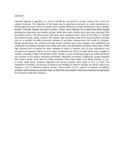| dc.description.abstract | Livestock keeping is regarded as a store of wealth for pastoralists in Kenya, besides their social and cultural functions. The objective of this study was to prioritize constraints to cattle marketing in a semiarid pastoral area of Narok in Kenya and to analyze efficiency of cattle marketing in transit markets located in Garissa, Kajiado and Narok counties. Primary data collection from traders was done through participatory interviews and market surveys, while time series market price data were obtained from secondary sources. Five focus group interviews were organized with a total of 61 traders in markets from Narok County, while a total of 187 traders who purchased cattle from transit markets provided data on a number of cattle purchased, purpose of purchase, buying prices and mode of transport. Market performance was analyzed through trader's market share, gross margins, Gini coefficient and coefficient of correlation between time series price data. The marketing constraints which were ranked high included lack of market for meat, trekking of cattle to markets, lack of price information and occurrence of diseases. About 10 % of traders purchased over 50 % of cattle which were supplied in markets, revealing a high concentration index. Further, a gross marketing margin per cattle purchased was positive in all markets revealing profitability. Moderate correlation coefficients existed between time series market price data for cattle purchased from Ewaso Ngiro and Mulot markets (r = 0.5; p < 0.05), while those between Dagoretti and Garissa markets were weak (r = 0.2; p > 0.05). The integration of markets, occurrence of diseases and trekking of cattle to markets are factors which may increase a risk of infectious disease spread. These results call for support of disease surveillance activities within markets in pastoral areas so that farms and systems which are connected are protected from threats of infectious diseases. | en_US |

